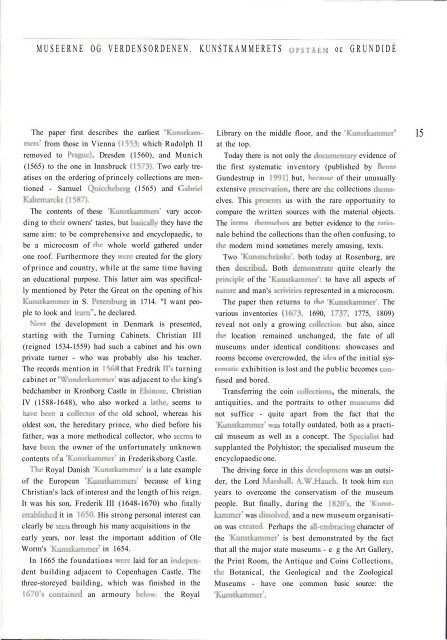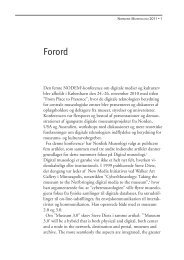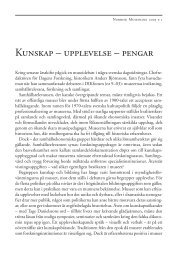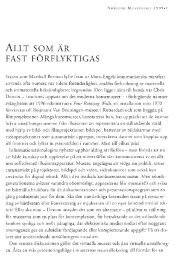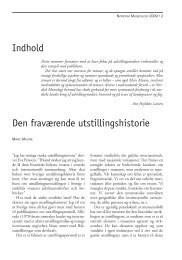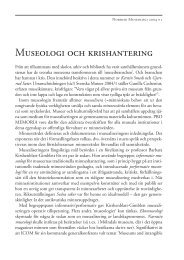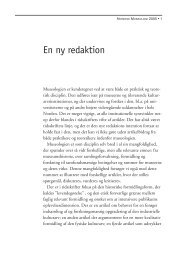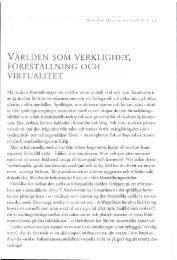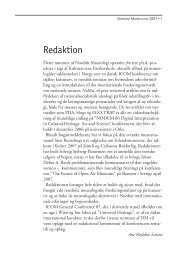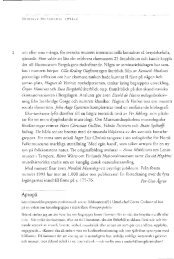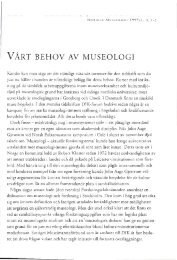ANMÄLAN - Nordisk Museologi
ANMÄLAN - Nordisk Museologi
ANMÄLAN - Nordisk Museologi
Create successful ePaper yourself
Turn your PDF publications into a flip-book with our unique Google optimized e-Paper software.
MUSEERNE OG VERDENSORDENEN. KUNSTKAMMERETS OPSTÅEN oc GRUNDIDÉ<br />
The paper first describes the earliest 'Kunstkammers'<br />
from those in Vienna (1553; which Rudolph II<br />
removed to Prague), Dresden (1560), and Munich<br />
(1565) to the one in Innsbruck (1573). Two early treatises<br />
on the ordering of princely collections are mentioned<br />
- Samuel Quiccheberg (1565) and Gabriel<br />
Kalremarckt(1587).<br />
The contents of these 'Kunstkammers' vary according<br />
to their owners' tastes, but basically they have the<br />
same aim: to be comprehensive and encyclopaedic, to<br />
be a microcosm of the whole world gathered under<br />
one roof. Furthermore they were created for the glory<br />
of prince and country, while at the same time having<br />
an educational purpose. This latter aim was specifically<br />
mentioned by Peter the Great on the opening of his<br />
Kunstkammer in S. Petersburg in 1714. "I want people<br />
to look and learn", he declared.<br />
Next the development in Denmark is presented,<br />
starting with the Turning Cabinets. Christian III<br />
(reigned 1534-1559) had such a cabinet and his own<br />
private turner - who was probably also his teacher.<br />
The records mention in 1568 that Fredrik II's turning<br />
cabinet or 'Wunderkammer' was adjacent to the king's<br />
bedchamber in Kronborg Castle in Elsinore. Christian<br />
IV (1588-1648), who also worked a lathe, seems to<br />
have been a collector of the old school, whereas his<br />
oldest son, the hereditary prince, who died before his<br />
father, was a more methodical collector, who seems to<br />
have been the owner of the unfortunately unknown<br />
contents of a 'Kunstkammer' in Frederiksborg Castle.<br />
The Royal Danish 'Kunstkammer' is a late example<br />
of the European 'Kunstkammers' because of king<br />
Christian's lack of interest and the length of his reign.<br />
It was his son, Frederik III (1648-1670) who finally<br />
established it in 1650. His strong personal interest can<br />
clearly be seen through his many acquisitions in the<br />
early years, nor least the important addition of Ole<br />
Worm's 'Kunstkammer' in 1654.<br />
In 1665 the foundations were laid for an independent<br />
building adjacent to Copenhagen Castle. The<br />
three-storeyed building, which was finished in the<br />
1670's contained an armoury below, the Royal<br />
Library on the middle floor, and the 'Kunstkammer'<br />
at the top.<br />
Today there is not only the documentary evidence of<br />
the first systematic inventory (published by Bente<br />
Gundestrup in 1991) but, because of their unusually<br />
extensive preservation, there are the collections themselves.<br />
This presents us with the rare opportunity to<br />
compare the written sources with the material objects.<br />
The items themselves are better evidence to the rationale<br />
behind the collections than the often confusing, to<br />
the modern mind sometimes merely amusing, texts.<br />
Two 'Kunstschränke', both today at Rosenborg, are<br />
then described. Both demonstrate quite clearly the<br />
principle of the 'Kunstkammer': to have all aspects of<br />
nature and man's activities represented in a microcosm.<br />
The paper then returns to the 'Kunstkammer'. The<br />
various inventories (1673, 1690, 1737, 1775, 1809)<br />
reveal not only a growing collection, but also, since<br />
the location remained unchanged, the fate of all<br />
museums under identical conditions: showcases and<br />
rooms become overcrowded, the idea of the initial systematic<br />
exhibition is lost and the public becomes confused<br />
and bored.<br />
Transferring the coin collections, the minerals, the<br />
antiquities, and the portraits to other museums did<br />
not suffice - quite apart from the fact that the<br />
'Kunstkarnmer' was totally outdated, both as a practical<br />
museum as well as a concept. The Specialist had<br />
supplanted the Polyhistor; the specialised museum the<br />
encyclopaedic one.<br />
The driving force in this development was an outsider,<br />
the Lord Marshall, A.W.Hauch. It took him ten<br />
years to overcome the conservatism of the museum<br />
people. But finally, during the 1820's, the 'Kunstkammer'<br />
was dissolved, and a new museum organisation<br />
was created. Perhaps the all-embracing character of<br />
the 'Kunstkammer' is best demonstrated by the fact<br />
that all the major state museums - e g the Art Gallery,<br />
the Print Room, the Antique and Coins Collections,<br />
the Botanical, the Geological and the Zoological<br />
Museums - have one common basic source: the<br />
'Kunstkammer'.<br />
15


